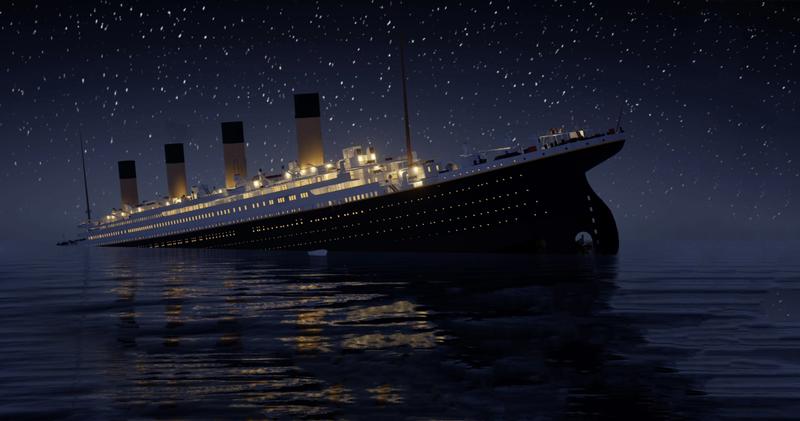A new documentary reveals the story of Chinese on board the Titanic, where six survived, Xu Fan reports.
 The Untold Story of RMS Titanic's Chinese Passengers, a new documentary focusing on the Chinese survivors aboard the infamous liner a century ago. (PHOTO PROVIDED TO CHINA DAILY)
The Untold Story of RMS Titanic's Chinese Passengers, a new documentary focusing on the Chinese survivors aboard the infamous liner a century ago. (PHOTO PROVIDED TO CHINA DAILY)
Over a century after RMS Titanic, the then-largest ship in the world, sank into the Atlantic Ocean in 1912, a new documentary, with James Cameron as the executive producer, is revealing a little-known story of Chinese on board.
Eight Chinese passengers were on the British liner on a single ticket in the third class, a common practice for the cheapest cabin back then. Six of them survived the tragic sinking.
Nobody ever claimed them. Nobody ever talked about them. … There is a deep psychological wound that the generation suffered, which is not just about ‘can I survive?’ or money
Arthur Jones, director
One of the deadliest disasters in maritime history, the Titanic collided with an iceberg during its maiden voyage from Southampton in England to New York, killing about 1,500 of more than 2,220 passengers and crew on board.
Fang Lang, a Chinese man, one of the last survivors rescued by a lifeboat of the ship, inspired Cameron to create the iconic scene of his blockbuster movie, Titanic, in which Leonardo DiCaprio, who stars as Jack, leaves the chances of survival to Kate Winslet's Rose by pushing his beloved onto a floating door.
This is told in the documentary The Six: The Untold Story of RMS Titanic's Chinese Passengers, which debuted in China on Friday.
Arthur Jones, the documentary's director, says he heard the Chinese survivors' story from his friend Steven Schwankert for the first time in 2015. Jones, a Shanghai-based British filmmaker, says he was shocked to find that few of his Chinese friends knew about it.
"We knew two of the eight Chinese passengers died, but nobody talked about the six survivors. Most of the Titanic survivors have their stories, but those six seem to have completely disappeared," says Jones, 47.
The Yorkshire native has lived in China since 1996. He once worked as a film reporter before shifting his interest to documentaries.
 Clues of these survivors' lives are pieced together, presenting a picture of early-generation immigrants struggling against discrimination and racism. (PHOTO PROVIDED TO CHINA DAILY)
Clues of these survivors' lives are pieced together, presenting a picture of early-generation immigrants struggling against discrimination and racism. (PHOTO PROVIDED TO CHINA DAILY)
The Six marks his second cooperative documentary with Schwankert, a New Jersey-born US researcher and historian, after their 2013 feature, The Poseidon Project, about the search of a sunken British submarine.
"I grew up near the ocean. I've always held an interest in maritime history, ships and shipwrecks since I was a little kid," says Schwankert, who traveled to China in the late 1980s.
Stumbling upon the Titanic's passenger list and other clues, Schwankert realized that he could turn his personal interest into a new project, for which he, alongside Jones, traveled to 20 cities and interviewed more than 100 people over five years, as well as read 1,000 archived works.
By studying events around the ship's sinking, the documentary's crew re-created some rescue moments and pieced together the story of the six survivors: Fang, Lee Bing, Chang Chip, Ah Lam, Chung Foo and Ling Hee.
Unlike most other survivors who were taken to hospitals or hotels in the United States, the six Chinese survivors were barred from entering the US because of the Chinese Exclusion Act, designed to curb Chinese immigration at that time.
They were reassigned from a freighter docked in New York bound for Cuba by the company that had hired them.
 The documentary features one of its major creators, Steven Schwankert, a US researcher, visiting the Titanic section of Fairview Lawn Cemetery in Halifax, Nova Scotia, Canada. (PHOTO PROVIDED TO CHINA DAILY)
The documentary features one of its major creators, Steven Schwankert, a US researcher, visiting the Titanic section of Fairview Lawn Cemetery in Halifax, Nova Scotia, Canada. (PHOTO PROVIDED TO CHINA DAILY)
Considering that the average survival rate for third-class male passengers was less than 20 percent, Schwankert says he believes the 75 percent survival rate of the Chinese workers was due to their experience traveling by sea.
"They had a particular understanding of what was happening on the ship. As sailors, they would know that the best thing to do is to get near the lifeboats early. We think they got onto the deck and took their opportunity when the boats were almost leaving," Jones says.
With experiments that ranged from building a full-size lifeboat and using 3D software to simulate the escape route, the documentary dispels rumors that the Chinese survivors donned women's dresses to hide as stowaways in the lifeboats.
"All those rumors are very unfair. The one thing we should remember about the Titanic is that there were spaces on all of the lifeboats. Some of the lifeboats from the Titanic were not even half full," says Jones. "Is it wrong to try to survive?"
The most thought-provoking part of the documentary is not just what happened to the Chinese passengers, but their poignant life paths as early-generation immigrants struggling against discrimination and racism, as well as fears that they might be forced to lose everything they had strived for.
"Nobody ever claimed them. Nobody ever talked about them. …There is a deep psychological wound that the generation suffered, which is not just about 'can I survive?' or money. There's something else that sits inside their hearts or minds," says Jones, adding that many Chinese immigrant laborers didn't get married, with their families ending with them.
The most highlighted survivor in the documentary is Fang, who had not told his survival story to his family with whom he later lived in the US.
The production team found limited records on the lives of the six survivors after the disaster other than their movement to different countries.
 The documentary's production team traveled to 20 cities and interviewed more than 100 people over five years. (PHOTO PROVIDED TO CHINA DAILY)
The documentary's production team traveled to 20 cities and interviewed more than 100 people over five years. (PHOTO PROVIDED TO CHINA DAILY)
In 2019, when the documentary was in postproduction, Jones and Schwankert were watching a scene in Cameron's film Titanic about a young Chinese man floating with a piece of wood. The shot was among more than 20 scenes cut from the theatrically released version, but kept in DVD copies. Realizing that the character could be the archetype of Fang in their project, Jones contacted a lawyer of Cameron, and was surprised to learn that Cameron had heard about their documentary and was willing to accept their interview.
"We wanted to know how Cameron knew about this story. Why did he film it? Why did he delete it? We had a lot of questions," says Jones, who flew to meet Cameron in New Zealand along with Schwankert.
"Cameron was very helpful. He knows so much about the Titanic. He told us that the story of Fang Lang had been a big influence on his movie. He had a lot of opinions about discrimination against Chinese people and the problems of racism," Jones says, adding that Cameron cut the scene as it looked like an unnecessary repetition of the scene with Rose and Jack, which would affect the storytelling pace.
Cameron offered free footage from his movie to the duo and became the executive producer of the documentary that retells the ship's story from a Chinese perspective.
"Every generation after the sinking of the Titanic kind of uses the ship as a way to talk about society," says Jones, adding that the disaster brought out issues such as class discrimination.
Their documentary wants to show "issues of ethnicity and nationality and how that affects people's lives".
Contact the writer at xufan@chinadaily.com.cn


